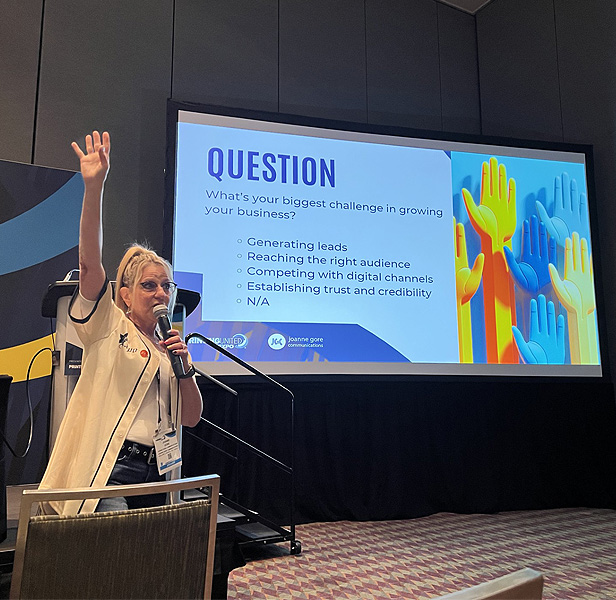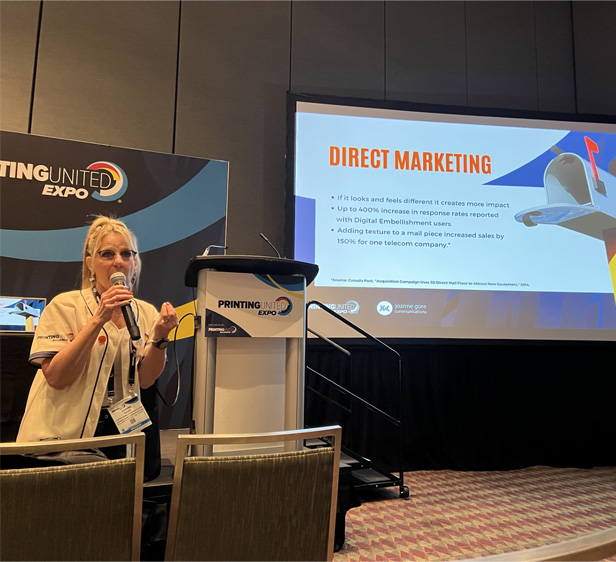Key Takeaways
• Printers should prioritize customers who are most likely to buy quickly and spend the most, rather than chasing uncertain leads. This strategy maximizes efficiency and profitability.
• Tactile print elements and digital integrations like QR codes and augmented reality enhance engagement, trigger emotional responses and drive conversions – especially among younger, tech-savvy buyers.
• Success in print sales requires a flexible, short-term road map. Breaking goals into “now, next and later” phases helps printers stay agile and focused amid industry changes.
The tired narrative is that print is dead and digital killed it, and by this point anyone paying attention to the print industry knows that that’s not true. Digital has changed the landscape, sure. And the world is changing every day, with new benefits and new challenges creating new ways of doing business for printers and print distributors, as well as those looking to join the print space.
And while it can be chaotic and difficult, there are ways to make sense of things and turn a tidy profit in print, provided you know your goals and have a realistic path to getting there.

That was the message from Joanne Gore, president and chief strategist of Joanne Gore Communications, who presented a session entitled “Thriving in Chaos: How To Make Money as a Printer in a Digital World” at PRINTING United Expo on Oct. 22 in Orlando. She put her mission succinctly:
“My mission is to help the print industry sell more print,” she said to attendees.
The world is rapidly changing, she said. It wasn’t too long ago, relatively speaking, when printers were doing things manually. In what seems like a blink of an eye to some people in the industry, the print world has gone digital. Even still, as the means of printing or delivery change, the things that customers are looking for have basically always remained the same.
Gore said that buyers are expecting four things: customization, sustainability, speed and value. The digital era, though, has changed some of the more niche customer expectations. These are things that create a company’s culture more than just the products they sell. Gore said that buyers today are motivated by storytelling, brand values, social proof and reviews, simple online experiences, and ethical sourcing and environmental impacts.
Buyers know what they want, and the modern print seller needs to deliver the product and do so in a way that makes the buyer feel good. Even in an industry like print that has seen its share of consolidation, it’s not easy to get your name out and cut through the noise – but it’s crucial.
Time Is of the Essence
Gore explained that websites, web presences or online advertising are essentially elevator pitches anymore. Attention spans are shrinking thanks to the sheer mass of choices on streaming services and entertainment platforms, to say nothing of the endless scroll of social media. She said that you only have about five seconds to show that your brand is worthy of the potential customer’s time. Actually, it’s more like three seconds.
And it requires consistent exposure, too.
“You, your brand, need to be in front of somebody at least 10 times before somebody even recognizes your brand,” Gore said.
The goals for just getting your foot in the door and in front of a potential customer boil down to three steps: Stand out, stop the scroll and be remembered.
“You will get sick of your message and your tag line and your call to action,” she said. “It doesn’t matter, because they have not heard it, and that’s what matters.”
New customers are only part of the equation, though. Gore believes that it’s simpler to get 10 customers in the door than it is to turn those existing 10 customers into long-term repeat buyers.
You, the salesperson, need to choose the path you take for your sale and how you allocate your resources and energy.
The Quickest Path to Money
That idea of finding the most direct route to a quality sale is a concept Gore called “quickest time to money.” This doesn’t just mean the quickest sale, though.
“Who is going to buy the most from you in the shortest amount of time and spend the most amount of money?” she asked. “Go after more people like that. Stop banging your head trying to go after the business that might be there, but you’re going to spend so many cycles of energy instead of going after the quickest time to money.”
Essentially, you might know that there’s a bigger fish in the pond, but that doesn’t mean you shouldn’t cast out bait that might attract the more plentiful and easier-to-catch fish when you really need to reel something in ASAP.
“Once you have that working, you can go to the next segment and the next segment,” she said.
Grow Your Conversations
Evolution of your sales process extends to your communications. Think of it in terms of dating. You can only do small talk about the weather for so long. Eventually you need to ask something a little deeper if you want to establish a real connection.
Gore called this “going from cold calling to warm conversations.” This can be done on social media platforms like LinkedIn, relating to prospects through their humanity and sharing real-life stories. If your customers’ buyers are on another platform like Instagram, this means meeting them where they are, even if it doesn’t come naturally.
“You’ve got to know where your money is coming from and where they’re hanging out,” Gore said.
That, she added, is how you can attract a new generation of business with younger buyers.
Multisensory Design
Gore connected with everyone in the audience before she even introduced herself. At each seat, she left a bookmark with a QR code directing guests to her website. More than the code and information, she said, the design of the way the ink lays on the paper is just as important.
“The first thing everybody did was touch it,” she said. “You flipped it over and you probably went, ‘Oh, one side is flat and matte, and the other is shiny.’”

Gore said that anyone selling any physical product can use this idea of touch, but print especially has a quality that lends itself to what she calls “petting print,” which then adds to sales. This can be the packaging for a product or the product itself.
When you can get someone to pick something up and touch it, and then keep touching it or holding it, they are, quite literally, petting the print. It can be packaging that has an interesting feel, or the decoration stands out where the customer wants to run their fingers on it for a second.
“If you touch it, you have to have it,” Gore said. “The longer you can get someone to touch something or hold something, the more likely they will be to actually purchase. Almost all unplanned buying is a result of touching, hearing or smelling. The more senses you can evoke, the more they will remember the experience, the more they will remember the brand and the more likely they will be to actually buy your product.”
In print, this can also carry over to items like direct mail that can use different paper weights and materials, or even scents to stand out from what would otherwise be considered junk mail. Little psychological tricks like using red envelopes or puffy packaging make recipients more likely to hang onto something, too.
For printers and distributors, this psychology is something that you can use to leverage higher sales. Once you convince your customer that these embellishments are vital to the advertising process, you can charge accordingly.
“It’s not a commodity, it’s a value-add,” she said. “This is how you make money as a printer. Just because it might cost you 5 cents to print something, you don’t have to tell them that. You could charge them $5 more or $50 more or $100 more because it’s all about that perceived value.”
The Phygital Realm
Digital didn’t replace physical print. It complemented it. Once you understand that, you’re no longer battling against something that can become an aid. Things that are now ubiquitous in print, like QR codes, variable data print, augmented reality and interactive mail campaigns, are great examples of this, and align your print product with younger generations of buyers who grew up with technology like smartphones and social media.
“They bridge that print experience with the digital world that everybody’s comfortable with,” Gore said.
She used an example of when leveraging good customer data with a well-executed print experience can convert into a sale.
“Somebody’s shopping online. They get a pair of shoes and put them in the cart, but they stay in the cart,” she said. “Two days later, they get an offer in the mail for those shoes at a discount with a QR code. You’ve put it in their hand. You’ve put the shoes in their hand.”
Gore said that these “phygital” experiences do more than just make print relevant in 2025: They trigger emotional responses that create a real drive to action.
She also used the example of Snoop Dogg’s wine company, which prints labels with interactive elements.
“If Snoop Dogg’s doing it, it’s got to be good.”
Planning Your Road Map
Understanding design and being clever are great, but if you’re not organized in your strategy, it’s just throwing things at the wall to see what sticks. And all of those things you threw at the wall cost money and time.
To ensure profitability in print, when the odds can feel stacked against the salesperson, Gore recommends looking at your path forward in three-month increments.
“You need to focus on what you need now, what you need next and what you need later,” she said.
This means looking at your business and looking at what you need to get to that next level, and doing that right away. What you do in that first three months should be planned out to the most minute detail. Those next three months, she said, should be “written in pen,” but still with the possibility of change. From six months, you’re writing in pencil.
“We really can’t predict more than six months out,” she said. “We can guess, but you always have to be in a three-month window.”
She uses the current example of the Canada Post strike as something that can come up and upend even the most well-laid plans.
When in doubt, Gore said that you can simplify your plan to three steps: Know your value, show your value and grow your value.
Understand who you can help by understanding your quickest time to money. Understand how you can help these customers by turning literal touchpoints into measurable interactive experiences that become sales. Understand why your print matters by making it a part of your customers’ brand culture that customers care about so deeply. Understand modern innovations like QR codes, personalization and postal incentives. And finally, understand how to make your print essential to a wide variety of customers and create new revenue streams for a sustainable business.
“Because in a digital world, smart printers don’t just survive,” Gore said. “They thrive.”



